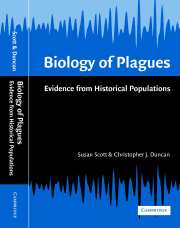Book contents
- Frontmatter
- Contents
- Preface
- Conversion table for imperial to metric units
- 1 Introduction
- 2 Epidemiological concepts
- 3 The biology of bubonic plague
- 4 The Great Pestilence
- 5 Case study: the plague at Penrith in 1597–98
- 6 Pestilence and plague in the 16th century in England
- 7 Plagues in the 16th century in northern England: a metapopulation study
- 8 Plagues in London in the 17th century
- 9 Plagues in the provinces in the 17th century
- 10 Plague at Eyam in 1665–66: a case study
- 11 Continental Europe during the third age of plagues: a study of large-scale metapopulation dynamics
- 12 The plague at Marseilles, 1720–22: an outbreak of bubonic plague?
- 13 Conclusions
- References
- Index
1 - Introduction
Published online by Cambridge University Press: 28 October 2009
- Frontmatter
- Contents
- Preface
- Conversion table for imperial to metric units
- 1 Introduction
- 2 Epidemiological concepts
- 3 The biology of bubonic plague
- 4 The Great Pestilence
- 5 Case study: the plague at Penrith in 1597–98
- 6 Pestilence and plague in the 16th century in England
- 7 Plagues in the 16th century in northern England: a metapopulation study
- 8 Plagues in London in the 17th century
- 9 Plagues in the provinces in the 17th century
- 10 Plague at Eyam in 1665–66: a case study
- 11 Continental Europe during the third age of plagues: a study of large-scale metapopulation dynamics
- 12 The plague at Marseilles, 1720–22: an outbreak of bubonic plague?
- 13 Conclusions
- References
- Index
Summary
We first became interested in plagues when studying the demography of northwest England (Duncan et al., 1992; Scott & Duncan, 1998), where an epidemic in the town of Penrith in 1597–98 killed some 40% of the population and initiated endogenous oscillations in the annual numbers of births and deaths. In this way, its effects persisted for 150 years. The outbreak spread rapidly, travelling 20 to 30 miles in 2 or 3 days and it was obvious that it was a biological impossibility that this was an outbreak of bubonic plague. We initially thought that this must have been an isolated outbreak of an unknown and unique infectious disease (Scott et al., 1996) but further study convinced us that this regional epidemic had many points in common with other outbreaks in England that were believed to be bubonic plague.
In this book, we have attempted an objective (though not exhaustive) study of the plagues that have ravaged humankind for hundreds of years, giving the biological, demographic and epidemiological viewpoints of the available historical evidence. Obviously, the difficulties faced are vastly greater than those of a modern epidemiologist investigating a new outbreak of an unknown disease today. He or she has an array of techniques available from microbiology and molecular biology, can take biopsy and autopsy samples with the back-up of a pathology laboratory, can make on-site investigations of the ecology and epidemiology of the disease, and can discover the clinical features and mode of transmission of the infection.
- Type
- Chapter
- Information
- Biology of PlaguesEvidence from Historical Populations, pp. 1 - 20Publisher: Cambridge University PressPrint publication year: 2001
- 2
- Cited by



